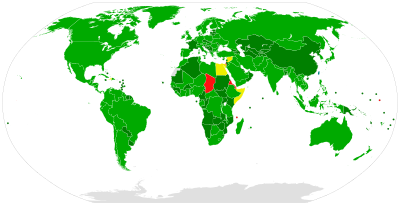Biological Weapons Convention

Participation in the Biological Weapons Convention
|
|||
| Signed | 10 April 1972 | ||
|---|---|---|---|
| Location | London, Moscow, and Washington, D.C. | ||
| Effective | 26 March 1975 | ||
| Condition | Ratification by 22 states | ||
| Signatories | 109 | ||
| Parties | 178 as of November 2016 (complete list) |
||
The Convention on the Prohibition of the Development, Production and Stockpiling of Bacteriological (Biological) and Toxin Weapons and on their Destruction (usually referred to as the Biological Weapons Convention, abbreviation: BWC, or Biological and Toxin Weapons Convention, abbreviation: BTWC) was the first multilateral disarmament treaty banning the production of an entire category of weapons.
The Convention was the result of prolonged efforts by the international community to establish a new instrument that would supplement the 1925 . The Geneva Protocol prohibits use but not possession or development of chemical and biological weapons.
A draft of the BWC, submitted by the British was opened for signature on 10 April 1972 and entered into force 26 March 1975 when twenty-two governments had deposited their instruments of ratification. It commits the 178 states which are party to it as of December 2016 to prohibit the development, production, and stockpiling of biological and toxin weapons. However, the absence of any formal verification regime to monitor compliance has limited the effectiveness of the Convention. An additional six states have signed the BWC but have yet to ratify the treaty.
The scope of the BWC's prohibition is defined in Article 1 (the so-called general purpose criterion). This includes all microbial and other biological agents or toxins and their means of delivery (with exceptions for medical and defensive purposes in small quantities). Subsequent Review Conferences have reaffirmed that the general purpose criterion encompasses all future scientific and technological developments relevant to the Convention. It is not the objects themselves (biological agents or toxins), but rather certain purposes for which they may be employed which are prohibited; similar to Art.II, 1 in the Chemical Weapons Convention (CWC). Permitted purposes under the BWC are defined as prophylactic, protective and other peaceful purposes. The objects may not be retained in quantities that have no justification or which are inconsistent with the permitted purposes.
As stated in Article 1 of the BWC:
"Each State Party to this Convention undertakes never in any circumstances to develop, produce, stockpile or otherwise acquire or retain:
The United States Congress passed the Bioweapons Anti-Terrorism Act in 1989 to implement the Convention. The law applies the Convention's convent to countries and private citizens, and criminalizes violations of the Convention.
The BWC has 178 States Parties as of November 2016, with Guinea the most recent to become a party. The Republic of China (Taiwan) had deposited an instrument of ratification before the changeover of the United Nations seat to the People's Republic of China.
...
Wikipedia
